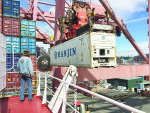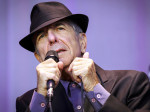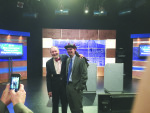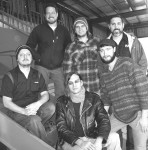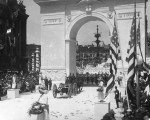Upland Brewery Crew: Top Left to Right Caleb Staton, Director of Sour Operations, Eli Trinkle, Cellarman, Pete Batule, VP of Operations; Bottom Left to Right, Adam Covey, Quality Assurance Manager, Nicholas Nehring, Assistant Brewer/Cellar, Cody Chestnut, Assistant Brewer/Cellar
By Pennfield Jensen
It was a woman who drove me to drink, and I never had the courtesy to thank her for it.
–W.C. Fields
Alcohol is a big deal in this country, and throughout the world. Hundreds of billions of dollars in play, innumerable lives enlivened, enriched, and, alas, also destroyed by “demon rum.”
The making and selling of alcohol can be a thrilling enterprise, but it is also a war zone. Not only do the major brands battle tirelessly over market share among themselves, especially as they seek to attract and capture the Millennial Market (all you LDA’s—Legal Drinking Age—out there between the ages of 21 and 32), there is a cultural war. Some call it the Craft Revolution. Others see it as the War On Craft. I have spent the last 13 years of my life deep in the trenches of this revolutionary war, having just a few months ago retired as Emeritus Executive Director of the American Craft Spirits Association. I began in San Francisco, but there have been many stops along the way including a stint at Upland Brewing Company assisting in its transition to new ownership, and as Executive Director of the Brewers Guild of Indiana.
I want to share some of what I have learned over the years and what I foresee coming down the pipe. I’m starting here under the beneficence of The Ryder with a three-part series: Beer, Bourbon and Beyond. For those who care, I’ve created a website of the same name (.com) to share in much greater detail what will be here just a scratch on the surface of what many believe to be the cradle of modern civilization: the creation and enjoyment in its many forms and guises of the ultimate frenemy, alcohol.
BEER, Part I
Beer is proof that God loves us and loves to see us happy.
—Benjamin Franklin
It is commonly said that “beer is food.” The justification for this is yeast. Yeast, that elegant, sensitive, tiny single-celled creature that converts sugar water into carbon dioxide and … ta da … alcohol! These blessed little critters that have been recorded “singing” (when the fluid temperature is perfect), just as they have been recorded “screaming” (when the temp is too hot).[2]
Although fermentation has been around for untold millennia, that yeast was the cause of fermentation is a relatively recent discovery by Louis Pasteur in 1857 who was investigating why beet juice sometimes made alcohol and sometimes soured. [3]
Although most, if not all, of yeast’s secrets have now been revealed, the fermentation process is worth a closer look. Beer fermentation proposes a charming and rather prophetic metaphor: typically, the brewer dumps (pitches) yeast into a cozy vat of warm malted-barley sugar water (the wort). Yeast heaven! Nothing to do but eat, excrete, and make more yeast. Those excretions, as most everyone knows, are primarily carbon dioxide and alcohol. And therein lies the rub. After a few days, the yeast produce so much alcohol that they pollute their heavenly habitat and either die or go into toxic shock. The process is called attenuation. At the point where the attenuation is complete, and the yeast are totally wrecked, victims of shock and awe, the merciful brewer lowers the temp to Oº C, (which puts all the living ones to sleep) and pours himself a sample pint of the consequence of that pollution: beer. Perhaps the Master Brewer similarly will show up and thank us for our work here with the planet…but on that score I have serious personal doubts.
But, hey, it’s all beer; it’s all good. Which brings up a monumental conundrum among aficionados: lagers vs. ales. Until very recently, lagers have reigned more or less uncontested upon the throne of beers. With the advent of craft brews, predominantly ales, that has begun to change…dramatically. There are now over 4,100 craft brewers in the United States. They make hundreds of different styles, and now generate almost 28% of all beer sales, and growing. The big guys are feeling the heat. Case in point: Constellation Brands’ billion-dollar acquisition of San Diego’s Ballast Point Brewery, (Yep, one billion. Hard to fathom.)
Until very recently, lagers have reigned more or less uncontested upon the throne of beers. With the advent of craft brews, predominantly ales, that has begun to change.
Fundamentally, the difference between lagers and ales is the kind of yeast that’s used. Lager yeast (Saccharomyces pastorianus) got started in the 1500’s somewhere in that part of greater Europe more or less around Pilsen, from whence hails pilsner. Ale yeast (Saccharomyces cerevisiae) also called Baker’s Yeast has been around since the beginning of civilization, and a powerful argument holds that the desire for beer is what kick-started staying in one place to grow the grain necessary to make the beer that sped non-stop from Mesopotamia 7,000 years ago to Budweiser sponsoring the Super Bowl, i.e., civilization as we know it.
The other part of the distinction between lagers and ales is cold brewing vs. warm brewing—often referred to as “top fermenting” (ales) and “bottom fermenting” (lagers). But the top-bottom distinction is not as precise as the cold vs. warm one. Cold-brewed lagers (under 10° C) give us those EZ Drink’n crisp, clean and sometimes slightly skunky flavored beers, and the “light” beers that have virtually no discernable flavor whatsoever. Lagers also age longer and at far lower temperatures in the eponymous process called “lagering.” Ales (brewing between 15° – 25° C) ferment faster, and tend to be fruitier, with big hugs all around for maltiness, hoppyness, and depth of flavor and color. But here’s the mystery within the conundrum: S.pastorianus does not exist wild anywhere in Europe! It has only existed in the vaults of the European brewers and their minions, and has been thus secreted since the early 1500s. So, where did it come from?
Saccharomyces (sugar-eating yeasts) thrive on oak trees. In 2011 a team of scientists found a strain of S.pastorianus growing wild on oak trees in Patagonia. Who would have guessed? So, to paraphrase an expert, “How the hell did it get to Europe 600 years ago?” [How about the Spanish and Portugese conquistadores desperate for oak to repair their ships, or the barrels they used to carry home the booty from a plundered continent? All good vectors for the good Sr. Pastorianius being a stowaway. Any takers for that theoretical scenario?] No matter how it got there, get there it did, and the rest, as they say is history. And today those good Dutch, German, and Belgian lagers can be found all around the globe.
Ales have taken a different trajectory. Popularized in England as pale ale, or Bitter, then enhanced famously during the Raj by adding more preservative hops to create India Pale Ale, and now the flagship IPAs of so many modern craft brewers. Hops, ah yes.
The wort (the barley malt sugar water) is the heart of every beer known to man. It is here where most of the bittering and flavoring elements that define a beer’s style and quality get introduced. The key bittering agents are hops, of which there are at least 32 varieties—many under duress thanks to climate change, especially in the Northwest where several of the more popular hop varieties are grown. And there is a metric for judging bitterness, IBUs (International Bittering Units), which most brewpubs proudly post, along with the ABV levels (alcohol by volume) for each style on tap. But the wort is where other flavorings are introduced as well: coriander, orange curaçao, chamomile—for wheat beer—and all sorts of crazy-ass things that irrepressible brewers like to toss in such as pumpkin, mulberries, raspberries, persimmons, and so on. Not to mention the classic Belgian “sour” beers with their ancient lineages that use wild yeast to make a beer then pack in fruit for a (secondary) barrel fermentation that can age for a year or more. When done right, sour blends with sweet to a fructuous delirium.
Barley, specifically malted barley, is the brewer’s grain of choice although other grains are also used, such as rye, or in the case of the popular wheat-based styles such as wit (white) or heffeweisen. In aggregate, the mixture of ground-up grains is called the mash. And the vat in which the mash is transformed into wort is called the mash tun.
A grain of barley looks a lot like a football that is rounded at one end. Basically, it’s a shell made of cellulose surrounding a cache of starch. The starch is a kind of battery, storing energy waiting for folks to come along and start using it. Those “folks” are enzymes, wormy-shaped proteins of enormous power. There’s a little packet of these at the tip of the kernel, along with a genetic package containing a barley embryo (the light bulb). When triggered by a pleasant shower of warm water, the enzymes wake up and start their work: slowly and carefully converting the starch in the kernel to sugar to feed the little green shoot that will grow and grow until it anchors itself in the earth and builds through the warm days into those amber waves of grain we sometimes sing about.
However, if, say, after three days, one halts this barley germination process by exposing our little sprout to high heat something new and exciting has happened: the barley kernel is now malted. The Scots famed use of burning peat for this imbues the malt with a flavor that once tasted can never be forgotten, and bless, bless, bless them for that! (But all that is in Part 2.) When malted barley is ground and mixed with hot water, the enzymes—now freed from their measured constraints—convert the mash of crunched up starch to sugar water in a process that’s virtually instantaneous. The wort is drawn off and the spent grain (mash to mush) discarded. (Many brewers provide the spent grain to cattle and buffalo ranchers.) The wort is boiled—to sanitize it—and hops et al added to make a giant pot of malted barley tea that once cooled, will serve as the short-lived heaven for our yeast.
But I should not gloss over the significance of wort creation, for here is where the art of brewing meets the science of it. So far, my description of wort is similar to saying automobiles use internal combustion. But there are differences between my Kia Soul and a Mustang GTO, namely “muscle” and “performance.”
Yeasts vary widely in their ability to tolerate alcohol. “Muscle” yeasts produce higher than average ABVs, and as taste trends have red-shifted toward hoppyer, higher alcohol beers, such as Trappist-style tripels and Imperial IPAs, these yeast strains have become popular. However, to get the higher ABV, the brewer needs heavier worts, that is he needs more available sugar. Comparing the weight or specific gravity of a particular wort to the weight of plain water provides a metric differential between the two. At the conclusion of fermentation a second measurement is taken and the difference between the incoming wort and the outgoing beer determines how much of the sugar has been converted to alcohol, call it performance. What the yeast does not consume is called residual sugar.
The true artistry comes when the brewer can combine just the right amount of “heavy” wort with just the right amount of hops so that the yeast attenuate leaving the least amount of residual sugar behind. Call it “balance.” Achieving that fulcrum point of perfect balance among all the variables is the Holy Grail for most brewers, and is the main reason you should pay attention to the specialty and seasonal releases from our great local breweries. Some say perfection has been achieved: Dark Lord Imperial Stout from Three Floyds in Munster, Indiana, but it is only released once a year, on Dark Lord Day. Some people wait in line all night to secure a few precious bottles (very limited release) at the brewery. If you’re up for it, this year Dark Lord Day is April 25th.
About now is when most of my audiences start glancing at their watches or longingly at the bar with its glinting bottles and beckoning taps, hoping for a pint. I don’t blame them, and that’s what I would like to do as well, join up and to take in the truly best part of the great process of brewing: drinking and savoring the combined artistry of brewer and brewed.
Adventures In Bourbon, Part II
It is notoriously difficult as it is to pinpoint how, where, and when “bourbon” began—its origins shrouded in myth, legend and outright malarkey.
It never ceases to amaze me that during all the years spent helping to build and then support the craft spirits industry, almost no one ever asked me which craft spirit was my favorite. Ninety times out of hundred, it was “What’s your favorite bourbon?” Still the same deal today. I have to ask myself ‘Why so, Joe?’ I can’t chalk all of it up to the fact that I live in Bloomington on the northern cusp of Appalachia. Albeit a majority of the corn used to make bourbon is grown in Indiana, and one of the largest distilleries, the largest when Sam Bronfman and Seagram’s ruled the spirits world, works its magic down the road as the less-than-lyrically named Midwest Grain Products (MGP) in Lawrenceburg. Nope, none of the above, although all certainly play a role.
Personally, I think bourbon fascinates because of its mystery—Why is it called bourbon? Where did it get started? Is it because of its seductive culture—Master Distillers, Thoroughbred Horses—and its unique way of flirting with every sensory pore in your body while never exhausting its ability to surprise and confound your expectations? All that, and bourbon is irrefutably America’s indigenous spirit. Indian corn, American white oak, and, if from Kentucky or Indiana, spring-fed water filtered through limestone laid down by the Tethys Sea 100 million years ago. It is a legacy that encourages an almost infinite variety of iterations while steadfastly defying even the worst travesties visited upon it. Fireball? Are you crazy?
Whiskey, including bourbon, is so inextricably intertwined with the birth and growth of the United States as to be virtually indistinguishable from it. You can pick almost any year or place to start, from the early use of whiskey—rye in the north, corn in the south—as a universal currency, to the storied introduction of alcohol taxation. My favorite point of embarkation is “The Whiskey Rebellion” of 1791. It was brought on by a new-fangled “excise” tax levied on spirits in order to pay down the debt created by the American Revolution. President George Washington leading federal troops ultimately quelled it. [WhiskeyRebellion.jpg c. 1795, attributed to Frederick Kemmelmeyer – Metropolitan Museum of Art, P.D.] No matter that George, at the time, happened to be the largest manufacturer of whiskey in the United States, kind of a one-man Diageo. We can assume he paid his taxes. George’s Mount Vernon estate and restored distillery on the majestic bluff overlooking the Potomac at Mount Vernon deserves a personal visit by every red-blooded American.
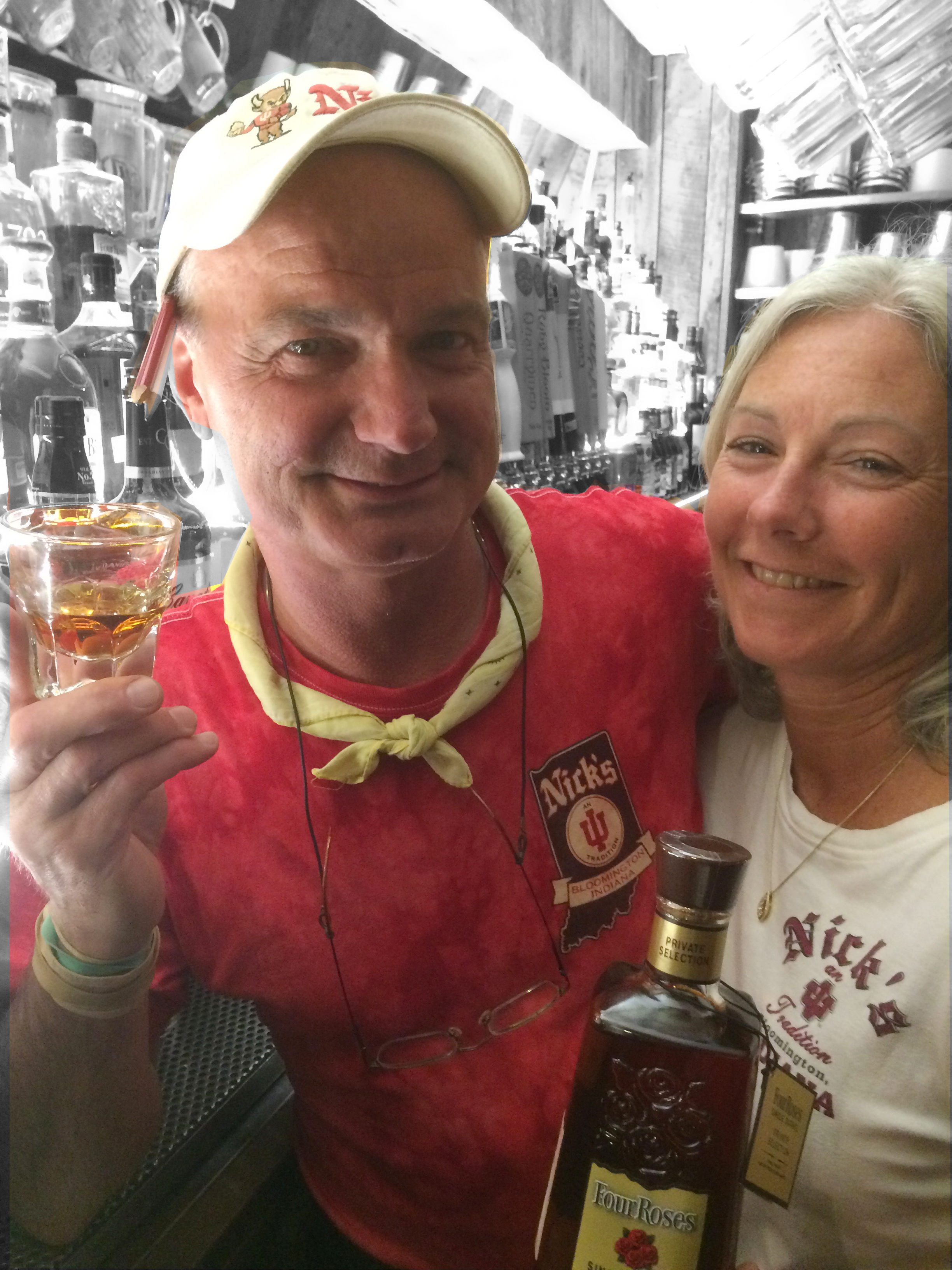
Nick’s owners Gregg “Rags” Rago and Susan Bright with a signature bottle of their hand-selected 131-proof single-barrel bourbon from Four Roses
Although it took six years for the 175 hold-out bourbon distillers in Kentucky to be brought to ground, Thomas Jefferson came to their rescue by honoring a platform promise of his fledgling Republican Party to repeal that odious “whiskey” tax. This was in direct opposition to Alexander Hamilton and his pro-tax Federalists. And, just like that, our two-party system, mostly, of American politics was off to the races.
Enter bourbon. Actually, enter bourbon barrels. By 1800, Louisville, in-not-yet-a-state-Kentucky, is host to one of the fledgling nation’s biggest transportation pains-in-the-ass: the Falls of The Ohio. Every shipment heading downstream to New Orleans has to stop, unload, and portage around the beautiful jumble of fossil Devonian reef then reload below it. There’s a lot of traffic, a lot of money to be made, and the Clark family is there to make it.
Revolutionary War heroes, neighbors to Jefferson in Virginia, the Clarks re-settled in pre-state Kentucky. It was to his friend John Clark’s son William (and Meriwether Lewis) that Jefferson handed the task of exploring his 1804 Louisiana Purchase. Lewis and Clark set out from the Clark mansion in New Albany, Indiana, across the Ohio from Louisville, organized their team in St. Louis, and you don’t need Quentin Tarantino to tell you how the West was won.
Yes, there is a dark side to William Clark’s story. With his extensive knowledge of the First Nations tribes he encountered, William Clark rose to the exalted post of Superintendent of the Indian Nations in 1822. Although he did much to preserve their legacies, following Jefferson’s ideal of inclusion rather than extinction, he nevertheless adhered to and executed The Indian Removal Act. In what for me is the saddest chapter in American history, the Act was a major tool of Andrew Jackson’s—Old Hickory’s—policy of genocide. In addition to outright removal from their ancestral lands, think the Cherokee “Trail of Tears,” and handing out smallpox infected blankets, Clark oversaw the deliberate use of high-proof, un-aged whiskey to destabilize native American communities and eliminate all resistance to the wholesale acquisition of Indian lands.
Meanwhile, whiskey was common currency throughout the rest of the nation, and demand for it was high. Courtesy of the Falls, the barrels of corn whiskey trekked to the Ohio from the interior of Kentucky, vaguely defined as Bourbon County, could languish dockside for weeks. Traffic was heavy and delays could be lengthy. There was also the steamy voyage downriver to New Orleans, which afforded further delays before the whiskey reached its destination decanter. But when it did, the amber-hued, sweet yet potent spirit with its unmistakable notes of vanilla and oak stood wildly apart from its clear-liquid “white lightning” cousins. People liked it, and asked for it. But what was it? “Oh,” we can imagine some purveyor answering, “that thar’s Bourbon County Kentuck’ whiskey!” The geography blurred, but the name, with its echoes of French support for the revolutionaries, some of whom were its very distillers, stuck.
As notoriously difficult as it is to pinpoint how, where, and when “bourbon” began—its origins shrouded in myth, legend and outright malarkey—there is one mystery that remains core and to this day unresolved: Who was it that thought of charring the barrels?
All whiskey comes off the still, clear and sparkling. They call it “white dog.” You can buy un-aged “white” whiskey almost anywhere. The misnomered “moonshine” popularized by hillbilly reality shows and troglodyte duck hunters is similar, except for the fact that many ‘shiners use up to 50% sugar as well as corn to create “sugar shine” served up in iconic Mason jars. All moonshine is legally produced white whiskey, except for the stuff that isn’t. And if you come across illegally produced whiskey, do be careful; it’s against the law to buy it or sell it, and it can blow your liver out of the sky like a mallard hit by a double load of 12-gauge shot.
Age is a big deal with bourbon. Legally called “straight” after two years in the barrel, bourbon, or any whiskey for that matter, rarely becomes drinkable before four years. For most bourbons, five to eight years is an optimal range with six and seven year-old bourbons defining the sweet spot. Above seven years, the distiller runs the risk of diminishing returns. Not only does evaporation, euphemistically called the “angel’s share,” take its toll, harsher “oakey” qualities start to appear that can render a barrel undrinkable. True, distillers can “blend” barrels, but only from their own stocks in a process called marrying. For example, the re-born Willett family’s bourbon stores, now Kentucky Bourbon Distillers, have brought us some magic marriages such as Noah’s Mill and Rowan’s Creek, not to mention Willett itself.
Bourbon, is so inextricably intertwined with the birth and growth of the United States as to be virtually indistinguishable from it.
As straightforward as barrel aging might seem, the reality is that distillers go to great pains to maximize the happy effects of the many burnt sugars and other flavors derived from charred oak. There are colossal slow-motion elevators to slowly rotate barrels through the various levels of the rick house to capture the “breathing” that a barrel experiences from the heat of summer through the cold of winter. Ten High, one of the early premium bourbons now in bottom-shelf ignominy, was so named for coming from barrels “ten high,” indicating a more dynamic aging, hence a better flavor. Any single barrel can have a marked difference from its siblings. Most distillers employ tasters, generally women who have naturally more sensitive taste buds, to match the selected barrels consistently to the flavor profile of a specific brand.
Brands drive the business, and brand protection has made many distillers loathe to reveal their recipes. Four Roses, for example, has five different yeasts that they have patented and which they use in combinations to create their specific bourbon expressions. A major exception is Maker’s Mark whose personnel proudly descant on their unique mash bill of 70% corn, 16% soft red winter wheat and 14% malted barley. The story goes that the recipe was derived by founder Rob Samuels, Sr. baking bread. The Samuel families 1950’s kitchen—all red-and-white gingham—is delightfully restored at Maker’s Mark. There is also a to-die-for Dale Chihuly blown glass ceiling installation at the distillery.
Bourbon’s popularity today belies its not-too-distant past as a moribund category. Skyrocketing demand world-wide has taken distillers by surprise. Knob Creek famously ran out of 7 year-old bourbon because seven years earlier no one at Beam had a clue regarding consumer demand seven years later. Changes and expansions are coming on hard and fast. Main Street in Louisville, home to over 83 pre-Prohibition distilleries, is rebounding with a plethora of re-fashioned distilleries and bourbon outposts. Buffalo Trace is available to retailers only on allocation, and don’t even think about getting your hands on a bottle of Pappy 23. It’s safe to say the situation is not going to change any time soon, and that’s the theme we’ll pick up in our next installment “And Beyond.”
As for the question, what’s my favorite bourbon? Easy Peezy: the one in my hand.
… AND BEYOND
“The paradigm, shifting is.”
–from Conversations with the Yoda, 1989
“Craft” is dead. Long live craft. Oh sure, there are brewers and distillers throughout America who get up every morning, slip on their Carharts and rubber boots and set out on the soul-satisfying task of fabricating what we hope are unique and delicious hand-made creations. But craft, as we once knew and loved it, is dead. It’s now gone mainstream. Perhaps this is inevitable, and maybe it’s not that bad.
Put another way, the Big Boys have all but conceded the field to the Small Guys. That means two things: One, what is local and regional will stay local and regional, and, Two, as brands achieve scale, the “Boys be wait’n.” Yep, the long-dreaded scourge of Very Large Players has arrived. And they bring with them a totally new approach. Rather than “crafty,” as witnessed by the erstwhile efforts of SAB-Miller’s “Blue Moon” or AB-INBEV’s equally noxious “Shock Top,” to trick consumers into buying factory beers they believe are “craft,” they have taken the path of outright acquisition. Forget Budweiser’s scandalously hypocritical slam against craft beer during the 2015 Super Bowl as they simultaneously gobbled up Washington State’s Elysian Brewery and Oregon’s 10 Barrel Brewery. Consider instead Bud’s big Breckenridge buy or Constellation Brands’ (ever had Corona?) billion-dollar purchase of Ballast Point Brewing.
Where Bernie or I might see corporate hypocrisy at work, others perceive the ascendance of craft as an essential transition from a folk-traditional to a high-stakes business model. As with most established, entrenched businesses finding themselves disrupted, not everyone saw it coming, and many of those who did were ticked off about it. Case in point: Eight years ago I was asked to make a presentation on craft spirits to the board of NABCA, the national association representing the Control States—those states with exclusive rights to buy and sell hooch. Governor-appointed, and dependent on the major distributors for their buying instructions, the craft spirits phenomenon had these directors bamboozled. I was bombarded with questions: Were the products any good? How much should we buy? What are consumers buying? How can we warehouse all these different skus?
What did I know? At the time only a few craft spirits brands were making noise in the marketplace, and almost all of them, if you exclude Tito’s, were highly regional, mostly small distilleries with loyal local followers. At the happy-hour reception afterwards, I was, in company of the steering committee, whose president, Mark Brown of Buffalo Trace, had generously provided several BT brands for our delectation., I was doing my part, within the responsible parameters of such an event, not to show any disrespect to Mssrs Stagg and Van Winkle. Mark, ever the gentleman, by and large had good things to say about craft, but several senior management types from the other major industry giants cornered me with pointed comment: You [craft distillers] are a threat to our brands. All our brands started small, Mom and Pops like your guys. We don’t need the competition. Whew!
Fast forward three years to a chance encounter with one of those same senior management-global-VP-types, and I was greeted with a big smile a slap on the back, and a major change of tune. We love you guys; you’re doing all our R&D for us! As soon as a distiller achieves scale, we’ll buy ‘em.
OK, when did this major tipping point occur? It was August 19, 2013, in Austin at the very first “Spirits Summit” hosted by the respected trade publication Wine and Spirits Daily. Danny Brager of Nielsen Associates had walked the crowd—a veritable who’s who of the spirits business in America—through his power point deck, to his conclusion. The data were incontrovertible: Craft spirits had a growth curve equal to or even stronger than that of craft beer at an analogous period in its development, and the future presented “a long runway.” Translated, Nielsen’s analysis foresaw no major obstacles facing the growth of craft spirits. Here, at last, was proof-positive of what many knew intuitively was the case. You could hear checkbooks snapping open.
An endearing quality of “craft,” if you admire pluck and rebellion, is its inherent resistance to the mantra of “go big or go home.”
Three years later, at the March Conference of my own organization, the American Craft Spirits Association, Danny revisited the data. Nielsen’s view was not only unchanged, but strengthened. Driven by “Millennials” who value authenticity, integrity and identity, craft beer, craft distilling, craft mixology, virtually all things “craft” was proving to be unstoppable. Not a train to stand in front of.
An endearing quality of “craft,” if you admire pluck and rebellion, is its inherent resistance to the mantra of “go big or go home.” True, there are some mega acquisitions in process, but not everyone wants to sell out. Rather, they are buying in. My term for these hold-ins is “legacy owners.” Starlight Distillery, part of the Huber Orchard and Winery complex on the fertile mesa above New Albany, exemplifies this concept. Seven generations of Hubers have grown fruit, made award-winning wine and brandy from their own orchards and vineyards, and now distill bourbon using their own corn. Huber’s economic impact can be gauged by its position as the third-ranking tourist destination in Indiana, after the Colts and the Indy 500. The distillery is, as one might expect, a gleaming showcase of copper and glass.
Similarly, Bently Heritage, a $40-plus million reconfiguration of an historic grainery in Minden, Nevada, will feature an over-the-top distillery-and-tourist complex with state-of-the-art mechanics utilizing grain grown on the Bently family’s Carson Valley farm holdings. And these are just two out of the hundreds of show-time distilleries expanding around the country that will awe and inspire all who visit them.
So, one asks, do these mega-trends spell doom for locals? I dropped in on Bloomington’s own Cardinal Spirits to hear what they had to say. What co-owner Adam Quirk revealed about Cardinal strongly reflected the underlying ethos of “craft” itself: authenticity is the lodestar. “The biggest part of building our brand is honesty,” he noted. “That’s what craft means. A craftsman makes something with his or her own hands, and does honest work. We make everything from scratch. We ferment and distill on site, and do our best to make a great product. It’s a matter of great personal pride,” Quirk observes. “But if your spirits are not good, people aren’t gonna buy ‘em. Simple as that.” And the ultimate goal? “Five years from now we want to be a well-known Midwestern distillery. But there’s more,” he adds. “It is critical to our mission to provide meaningful employment for ourselves and our staff. That’s really why we’re here.”
# # #
HOOCH AND HEALTH
I want to get drunk ‘till I’m off of my mind.
–George Thorogood, “One Bourbon, One Scotch and One Beer”
Alcohol can be fatal. Bingeing is a chronic phenomenon that is hugely popular among Millennials at major “party schools,” like IU. I’m no moralist, but I do side with Fritz Maytag of Anchor Brewing and Distilling who delivered the keynote at my first craft spirits conference in 2008. “Alcohol is not the problem,” he declared forcefully. “The problem is these kids never learned how to drink.”
I grew up in a somewhat Bohemian enclave of San Francisco. Alcohol, mostly wine, was enjoyed nightly at dinner by my parents, and throughout the year at nearly every occasion by everyone we knew. Think of the wedding scene in The Godfather and you can get a pretty good picture. I think it’s a shame that so many young adults enter the university sphere with little or no understanding of alcohol. Because, if you understand it, you will respect it.
This is a simplified version of what happens when you get drunk, but there will be a quiz later, so pay attention.
A pint of beer, a 5 oz glass of wine, or a 1 ¼ shot of vodka all contain roughly a half-ounce of pure alcohol each. Drinking six of these at one sitting, in any combination or order, is considered bingeing. Anyone with half-a-clue about what happens during the Dionysian debacle called Little Five, or has experienced any of B-town’s infamous Sports Bars late of a Friday or Saturday night knows six drinks to be a mere warm up. It takes roughly an hour for the liver to metabolize that half-an-ounce of pure ethanol. Do the math.
Your dear, dear liver first metabolizes the ethanol into acetaldehyde, a very toxic poison that the ancient enzymes that govern so much of our lives almost instantaneously convert to sugars that are converted to fat cells and stored by the liver. What doesn’t get metabolized collects in the bloodstream causing havoc.[1] Chug a pint beaker of 86° vodka and you’re either going to expel it as an offering to the ceramic gods, or you’re going to enter some form of inebriation bordering on toxic shock. Keep at it and you may find yourself waltzing with the Grim Reaper.
Drinking can and should be an enjoyable part of life. Drinking to get drunk is not. Getting drunk is stupid. Getting drunk with strangers is really, really stupid.
That’s it. Now, here’s the multiple-choice quiz:
I will Never Ever Drink Anything Alcoholic Ever!
I will endeavor to learn about the myriad styles and qualities of alcoholic beverages, and respectfully enjoy them
I will dismiss this “quiz” as a pile of moralistic crap from a dumb-ass scold and do whatever I want whenever I want to
Hey, it’s your life to live and to enjoy. Please do.
BOURBON DAVE SCHEURICH ON FERMENTING BOURBON
We know what is legally required to define bourbon, but how is it actually made? I asked an expert, “Bourbon” Dave Scheurich, the Distillery Manager for Woodford Reserve (ret.). Here’s Dave.
As you know, Bourbon whiskey requires at least 51% corn. Most distillers use #1 yellow corn that is first ground to a fine meal, mixed with water, and cooked at 212⁰ F for 30 minutes to totally liquefy the starches in the corn. The mash temperature is gradually lowered and rye or wheat meal is added to the slurry. The barley malt is added when this big vat of starch reaches 154⁰ F. The enzymes in the malt instantly convert the starch to sugar.
Although not required by law, most of us use a little backset stillage or “sour mash.” In the early years of making whiskey, distillers would make good batches and bad batches without knowing why. In the mid-1850’s James Crow (and others) learned that if they put some spent mash back into the cooking process they got consistently good whiskey. Since sour mash is very acidic, i.e., around 4.0 pH. Adding some into the cook deters the natural yeasts and molds in the air that surrounds us.
Wheat versus rye as the second grain in the mash bill is a matter of the distillers’ preference. Some people enjoy a spicy, complex bourbon (high rye) while others like soft and sweet bourbon (wheated). Maker’s Mark is a good example of a wheated bourbon.
LEGAL DEFINITION OF BOURBON
What Makes Bourbon “Bourbon”
- Must be manufactured in the United States
- Must be at least 51% Corn. Other allowed grains are Rye, Malted Barley, and Wheat
- Cannot be distilled above 160 proof (80% alcohol).
- Must be aged in charred new American white oak barrels for at least two years
- Must be casked no higher than 125 proof (62.5% alcohol)
- Must be bottled at no less than 80 proof (40% alcohol)
“IF BY WHISKEY”
“My friends, I had not intended to discuss this controversial subject at this particular time. However, I want you to know that I do not shun controversy. On the contrary, I will take a stand on any issue at any time, regardless of how fraught with controversy it might be. You have asked me how I feel about whiskey. All right, here is how I feel about whiskey:
If when you say whiskey you mean the devil’s brew, the poison scourge, the bloody monster, that defiles innocence, dethrones reason, destroys the home, creates misery and poverty, yea, literally takes the bread from the mouths of little children; if you mean the evil drink that topples the Christian man and woman from the pinnacle of righteous, gracious living into the bottomless pit of degradation, and despair, and shame and helplessness, and hopelessness, then certainly I am against it.
But, if when you say whiskey you mean the oil of conversation, the philosophic wine, the ale that is consumed when good fellows get together, that puts a song in their hearts and laughter on their lips, and the warm glow of contentment in their eyes; if you mean Christmas cheer; if you mean the stimulating drink that puts the spring in the old gentleman’s step on a frosty, crispy morning; if you mean the drink which enables a man to magnify his joy, and his happiness, and to forget, if only for a little while, life’s great tragedies, and heartaches, and sorrows; if you mean that drink, the sale of which pours into our treasuries untold millions of dollars, which are used to provide tender care for our little crippled children, our blind, our deaf, our dumb, our pitiful aged and infirm; to build highways and hospitals and schools, then certainly I am for it.
This is my stand. I will not retreat from it. I will not compromise.”
–1952 speech by Noah S. “Soggy” Sweat, Jr., a young lawmaker from the U.S. state of Mississippi, on the subject of whether Mississippi should continue to prohibition (which it did until 1966) or finally legalize alcoholic beverages
BOURBON DAVE SCHEURICH ON FERMENTING BOURBON
We know what is legally required to define bourbon, but how is it actually made? I asked an expert, “Bourbon” Dave Scheurich, the Distillery Manager for Woodford Reserve (ret.). Here’s Dave.
As you know, Bourbon whiskey requires at least 51% corn. Most distillers use #1 yellow corn that is first ground to a fine meal, mixed with water, and cooked at 212⁰ F for 30 minutes to totally liquefy the starches in the corn. The mash temperature is gradually lowered and rye or wheat meal is added to the slurry. The barley malt is added when this big vat of starch reaches 154⁰ F. The enzymes in the malt instantly convert the starch to sugar.
Although not required by law, most of us use a little backset stillage or “sour mash.” In the early years of making whiskey, distillers would make good batches and bad batches without knowing why. In the mid-1850’s James Crow (and others) learned that if they put some spent mash back into the cooking process they got consistently good whiskey. Since sour mash is very acidic, i.e., around 4.0 pH. Adding some into the cook deters the natural yeasts and molds in the air that surrounds us.
Wheat versus rye as the second grain in the mash bill is a matter of the distillers’ preference. Some people enjoy a spicy, complex bourbon (high rye) while others like soft and sweet bourbon (wheated). Maker’s Mark is a good example of a wheated bourbon.
LEGAL DEFINITION OF BOURBON
What Makes Bourbon “Bourbon”
- Must be manufactured in the United States
- Must be at least 51% Corn. Other allowed grains are Rye, Malted Barley, and Wheat
- Cannot be distilled above 160 proof (80% alcohol).
- Must be aged in charred new American white oak barrels for at least two years
- Must be casked no higher than 125 proof (62.5% alcohol)
- Must be bottled at no less than 80 proof (40% alcohol)
“IF BY WHISKEY”
“My friends, I had not intended to discuss this controversial subject at this particular time. However, I want you to know that I do not shun controversy. On the contrary, I will take a stand on any issue at any time, regardless of how fraught with controversy it might be. You have asked me how I feel about whiskey. All right, here is how I feel about whiskey:
If when you say whiskey you mean the devil’s brew, the poison scourge, the bloody monster, that defiles innocence, dethrones reason, destroys the home, creates misery and poverty, yea, literally takes the bread from the mouths of little children; if you mean the evil drink that topples the Christian man and woman from the pinnacle of righteous, gracious living into the bottomless pit of degradation, and despair, and shame and helplessness, and hopelessness, then certainly I am against it.
But, if when you say whiskey you mean the oil of conversation, the philosophic wine, the ale that is consumed when good fellows get together, that puts a song in their hearts and laughter on their lips, and the warm glow of contentment in their eyes; if you mean Christmas cheer; if you mean the stimulating drink that puts the spring in the old gentleman’s step on a frosty, crispy morning; if you mean the drink which enables a man to magnify his joy, and his happiness, and to forget, if only for a little while, life’s great tragedies, and heartaches, and sorrows; if you mean that drink, the sale of which pours into our treasuries untold millions of dollars, which are used to provide tender care for our little crippled children, our blind, our deaf, our dumb, our pitiful aged and infirm; to build highways and hospitals and schools, then certainly I am for it.
This is my stand. I will not retreat from it. I will not compromise.”
–1952 speech by Noah S. “Soggy” Sweat, Jr., a young lawmaker from the U.S. state of Mississippi, on the subject of whether Mississippi should continue to prohibition (which it did until 1966) or finally legalize alcoholic beverages
THE BUFFALO THEORY
In an episode of the Sitcom “Cheers,” Cliff explains “the buffalo theory” to Norm.
Well, you see, Norm, it’s like this: A herd of buffalo can only move as fast as the slowest buffalo. And when the herd is hunted, it is the slowest and weakest ones at the back that are killed first. This natural selection is good for the herd as a whole, because the general speed and health of the whole group keeps improving by the regular killing of the weakest members.
In much the same way, the human brain can only operate as fast as the slowest brain cells. Now, as we know, excessive intake of alcohol kills brain cells. But naturally, it attacks the slowest and weakest brain cells first. In this way, regular consumption of beer eliminates the weaker brain cells, making the brain a faster and more efficient machine.
And that, Norm, is why you always feel smarter after a few beers.





